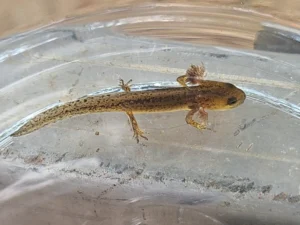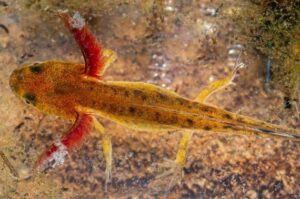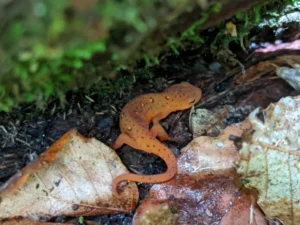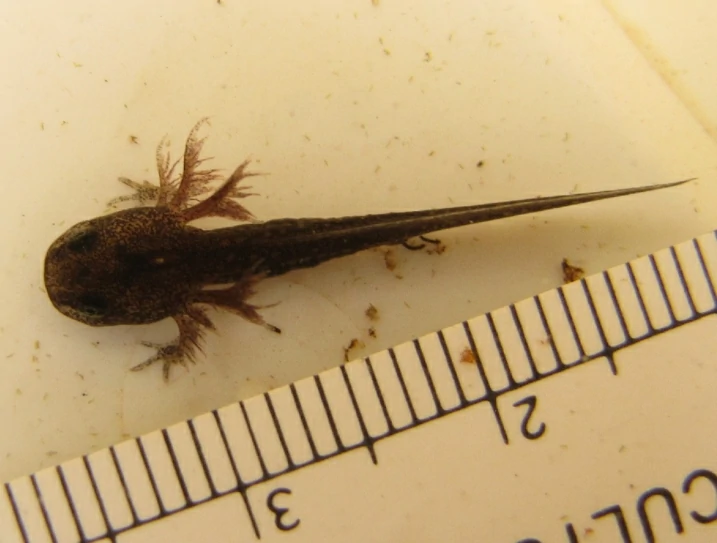If you’ve ever looked into a pond in spring, you might have noticed tiny, feathery newts moving among the plants. At first, they look like little fish. But if you look closer, you might wonder: do newts have gills?
Yes, newts have gills, but only during certain stages of their lives. These gills let them breathe underwater when they are young, and in some species, adults may even keep them under special conditions.
Why Baby Newts Need Gills
When a newt hatches from its egg, it starts life as a larva completely underwater.
At this stage, its lungs aren’t ready yet, so gills are the only way to get oxygen.

The gills are outside the body and feathery, almost like tiny crowns or delicate fans on the sides of the head.
Water moves through them, letting oxygen pass into the blood.
Without gills, a larva wouldn’t survive in a pond, because there’s a lot less oxygen in water than in air.
How Gills Work in Larval Newts
The gills wave back and forth in the water, constantly moving fresh oxygen across the surface.
Tiny blood vessels inside pick up the oxygen and carry it through the body.
At the same time, carbon dioxide leaves the body in the same way. It’s a simple but very effective system for breathing underwater.
Do All Newts Keep Their Gills as Adults?
Most newts lose their external gills as they go through metamorphosis. (Metamorphosis just means changing from a larva into a juvenile and then adult.)
As their lungs grow, the gills shrink and eventually disappear.
But in some species, or in unusual conditions, adults may keep gills for life.
This is rare but happens when water is plentiful and oxygen levels are steady.

In these cases, the adult newt can breathe through both gills and skin, giving it an extra edge in water.
How Gills and Lungs Work Together
During the switch from water to land, newts rely on both gills and lungs for a while.
-
Gills keep pulling oxygen from the water while lungs grow.
-
Lungs slowly take over as the main breathing tool on land.
-
Skin acts as a backup, letting oxygen in and carbon dioxide out whenever it can.
This overlap makes sure the newt always has a way to breathe, whether underwater or on land.
Why Gills Look So Frilly and Colorful
Have you noticed how newt gills almost look like tiny red or orange feathers? That’s not just for show.

The frilly shape increases surface area, letting the newt absorb more oxygen efficiently. The color comes from blood vessels inside, carrying oxygen to the body.
In short, gills are perfectly built for small aquatic creatures, making the most of the limited oxygen in water.
Can You See Gills on Efts?
When newts leave the water as juveniles (like the bright red efts) you won’t see the external gills anymore. By then, lungs have taken over.

If you look closely at a young larva before it leaves the pond, the gills are always waving in the water, always moving, always working.
It’s almost like a tiny underwater dance keeping the newt alive.
How Gills Protect Newts From Danger
Gills don’t just help them breathe, they also shape how they behave.
Larvae stay near plants and rocks to hide from predators, using their gills to keep breathing while staying out of sight.
The delicate gills make them slow and careful swimmers, which actually reduces the chance of being noticed.
Even though they look fragile, gills are a powerful survival tool.
Are Gills the Same for All Amphibians?
No. Frogs, salamanders, and newts all start with gills, but they differ in shape and use:
-
Frog tadpoles have internal gills at first, then outside gills for a short time.
-
Salamanders and newts often keep outside gills longer, giving them more flexibility in water.
-
Axolotls are famous for keeping gills their whole lives.
Newts are somewhere in the middle, losing gills as adults but relying on them heavily as larvae.
What Happens if Gills Are Damaged?
If a newt’s gills get injured (by pollution, rough handling, or predators) the larva may struggle to get enough oxygen.
It will often hide more, move less, and grow more slowly.
Luckily, newts have backup systems: lungs start developing, and the skin can absorb oxygen too. Still, healthy gills are very important for a strong start in life.
Conclusion
So, do newts have gills? Yes, but mainly when they’re young. These frilly, feathery organs let them breathe underwater efficiently while growing in ponds.
As newts change into juveniles, gills shrink and disappear, replaced by lungs and skin breathing.
Gills are a perfect example of how newts are built to survive in both water and land at different stages of life.
Without them, young newts wouldn’t make it to the bright red efts crawling across forest floors, or the sleek adults going back to ponds to breed.
Next time you look closely at a pond in spring, take a moment to spot the waving gills of newt larvae. It’s a glimpse into a hidden world, where survival starts with something as delicate as a tiny feather of life.
Hi, my name is Ezra Mushala, i have been interested animals all my life. I am the main author and editor here at snakeinformer.com.

